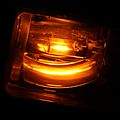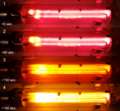Sodium vapor lamp facts for kids
A sodium vapor lamp is a special type of light bulb. It creates light by sending electricity through a gas that contains sodium metal. You often see these lamps used as streetlights because they are very bright and efficient.
Contents
Types of Sodium Lamps
There are two main kinds of sodium vapor lamps:
- Low-pressure sodium (LPS) lamps: These lamps produce a very strong yellow-orange light. They are great for places where seeing true colors isn't important, like some highways or industrial areas. This is because their light is almost one single color.
- High-pressure sodium (HPS) lamps: These lamps give off a broader range of colors, often appearing orange or pinkish-white. This allows people to see different colors more easily than with LPS lamps. HPS lamps are commonly used for street lighting in cities and towns.
How Sodium Lamps Work
Sodium vapor lamps work by heating up sodium metal inside a special tube. When electricity passes through the tube, it makes the sodium turn into a gas. This gas then glows, producing the bright light we see. The color of the light depends on the pressure of the gas inside the lamp.
Safety and Disposal
Sodium vapor lamps contain a small amount of sodium metal and sometimes mercury. Because of these materials, it's important to dispose of old sodium vapor lamps properly. They should not be thrown in regular trash. Instead, they need to be recycled or taken to special collection points to prevent harm to the environment.
Related pages
Images for kids
-
Spectrum of high-pressure sodium lamp. The yellow-red band on the left is the atomic sodium D-line emission; the turquoise line is a sodium line that is otherwise quite weak in a low pressure discharge, but becomes intense in a high-pressure discharge. Most of the other green, blue, and violet lines arise from mercury.
See also
 In Spanish: Lámpara de vapor de sodio para niños
In Spanish: Lámpara de vapor de sodio para niños












